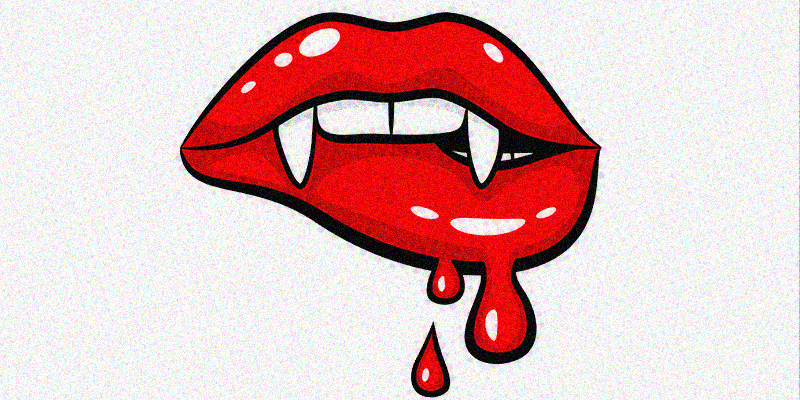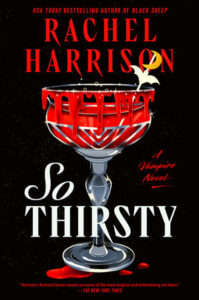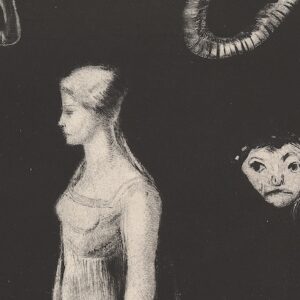“This is the skin of a killer, Bella.” I’ve got to be honest; this line has been quoted to me an astonishing number of times over the last few months. Not at random, thankfully, but when I bring up the fact that I wrote a vampire novel. Twilight’s sparkly shadow looms large. It was a cultural phenomenon; it was also kind of a joke. Remember how they made a parody movie about it called Vampires Suck? That’s pretty wild! While vampires never fully disappeared, I do think it’s taken a bit of time for us as a society to collectively heal from Edward Cullen. For us to embrace the vampire again, even if it is still with a little snicker.
When I think of the vampire novels that have come out recently, I’m in awe of the broad spectrum of themes, of the cleverness and emotional depth these novels possess. As far as monster as metaphor, the vampire offers many compelling avenues of exploration. Perhaps that’s why they’ve endured for so long, why they are truly eternal.
In House of Hunger, Alexis Henderson uses vampirism to interrogate power dynamics, specifically related to class. Set in a world where nobles drink the blood of their servants for their own vitality, our protagonist Marion Crane is whisked away from her struggles in the slums to a life of luxury serving as a bloodmaid to Countess Lisavet. Marion becomes enthralled by the glamorous and self-assured Lisavet, and though it seems like Lisavet returns Marion’s feelings and the two become lovers, there’s an uneasiness to their connection because Lisavet is, to put it plainly, Marion’s boss. Not to mention she’s quite literally draining Marion.
In our world of unpaid interns, insufficient minimum wage, inflation, a widening wealth gap, it’s not that far a stretch to feel like we’re giving our life force to a system designed to destroy us, that sees us as disposable. Vampires are eternal, powerful, often portrayed as affluent, often sexy and alluring, often untouchable. As cries of “eat the rich” grow louder, it begs the question how the hell are we going to do that when they’re bleeding us dry?
Nat Cassidy explores a similar theme in Nestlings, though in a contemporary, our-world-but-with-monsters context. While House of Hunger delves more into that power dynamic in a romantic relationship (as does Gwendolyn Kiste’s brilliant 2022 novel Reluctant Immortals), Nestlings is a painful rumination on how easy it is to become prey when there are predators everywhere.
In Nestlings, married couple Reid and Ana are reeling after the birth of their daughter Charlie has left Ana paralyzed. Struggling both emotionally and financially, they think their luck has changed when they win a NYC housing lottery (imagine?) for a dream apartment at the Deptford, one of those historic, famous Manhattan buildings that people ogle when the pass by. What’s immediately apparent to Ana is that not all is as it seems in the building, but Reid is swept up in its charm, by the fairy tale of their luck changing. The marital strain they face as they try to find the line between hope and delusion for a better future is heartbreaking, and perhaps the true horror of the novel has nothing to do with the monsters lurking in the building, but the way we can be broken down as we strive for a good life in a world that makes it so damn hard.
Nestlings is a vampire book on two different levels. Yes, there are those pesky, dangerous, draining creatures, but also the very building, the very city, the entire stupid, ruthless society we live in, is constantly taking from us. The resurgence of vampire stories at this particular moment in time, as those in power seem to care less and less about those without, makes perfect sense.
Liz Kerin’s Night’s Edge duology is just as timely, while offering an inventive spin on the vampire. In the novels, vampirism comes in the form of a virus. The fear and panic surrounding the infection summon peak COVID memories—there are scanners in place to test for infection outside of bars, restaurants, stores, etc. While that anxiety thrums under the surface of the novels, they’re not about the virus. Kerin uses vampirism as a metaphor for addiction, exploring codependence, toxic relationships, and trauma. These novels are fast-paced and entertaining but make no mistake— you’ll be dogearing pages and scribbling notes about things you need to talk about with your therapist. Nuanced, original, profound—this is about as far from Twilight as you can get. I don’t know if, in the wake of vampire/werewolf love triangles, people (okay, publishing) would have been able to open their hearts and minds to stories like this.
While vampire romance has a long, rich history—romance and erotica have generally been met with eyerolls until fairly recently. Sure, plenty of judgement remains, but I think there’s been pushback on the merit of these subgenres as of late, which I believe bleeds into the resurgence of the vampire. V Castro’s Immortal Pleasures is a super sexy vampire book, with ancient Aztec vampire Malinalli out for vengeance and pleasure. In a world where women’s rights are being stripped away, it’s cathartic to read about a woman’s satisfaction. With all the aforementioned power imbalances at play, of course there’s a thirst for fiction where a woman is in power, where she takes what she wants, drinks till the last drop no remorse, licks her fingers clean. Of course there’s a thirst for sexy vampire fiction.
I didn’t set out to write a sexy vampire novel. I didn’t set out to explore power dynamics, or women’s anger, or desire. I was staring in the mirror one day, lamenting signs of aging in my face, and it suddenly occurred to me that a) vampires cannot see their reflections and b) don’t age. That’s what got the wheels turning for me. At thirty-five, it’s all Botox and retinoids and Omega-3’s and I would absolutely love it if I could spend five minutes on the internet without being reminded that I’m getting older and that’s bad. Because is it? Or is society just telling me it is, so I spend my hard-earned money on some stupid cream? Thirty-five is too young to feel like death is nigh because of a lack of collagen production.
Contemplating aging and mortality within the framework of vampires was my original intention for So Thirsty. The book is still about those things, but apparently my subconscious was like “What about desire? What about deprivation? What if the thing you wanted was the thing you needed to survive?” As a woman who grew up in the nineties, steeped in diet culture, and slut-shaming, and all that, it became clear to me that as I wrote these vampires, I was reckoning with my own complicated relationship with desire and satisfaction and guilt and shame.
See what I mean? The vampire metaphor goes hard! Endless possibilities. And there are so many books I haven’t mentioned here, which just goes to show how back vampires are. And I for one am grateful that they’re eternal, because on top of everything else, they’re just so fucking fun.
***


















